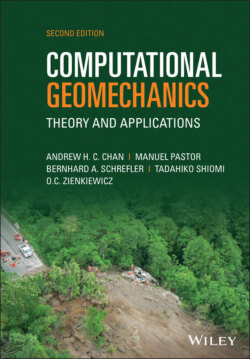Читать книгу Computational Geomechanics - Manuel Pastor - Страница 29
2.5.1 Kinematic Equations
ОглавлениеAs indicated in Chapter 1, a multiphase medium can be described as the superposition of all π phases, π = 1, 2, …, κ, i.e. in the current configuration, each spatial point x is simultaneously occupied by material points Xπ of all phases. The state of motion of each phase is however described independently.
In a Lagrangian or material description of motion, the position of each material point xπ at time t is a function of its placement in a chosen reference configuration, Xπ and of the current time t
(2.55)
To keep this mapping continuous and bijective at all times, the determinant of the Jacobian of this transformation must not equal zero and must be strictly positive, since it is equal to the determinant of the deformation gradient tensor Fπ
(2.56)
where Uπ is the right stretch tensor, Vπ the left stretch tensor, and the skew‐symmetric tensor Rπ gives the rigid body rotation. Differentiation with respect to the appropriate coordinates of the reference or actual configuration is respectively denoted by comma or slash, i.e.
(2.57)
Because of the non‐singularity of the Lagrangian relationship (2.55), its inverse can be written and the Eulerian or spatial description of motion follows
(2.58)
The material time derivative of any differentiable function fπ(X, t) given in its spatial description and referred to a moving particle of the π phase is
(2.59)
If superscript α is used for , the time derivative is taken moving with the α phase.
